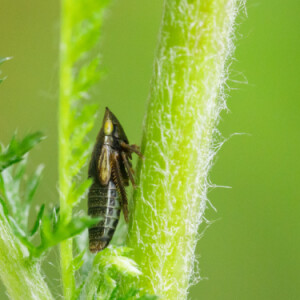Aphrodes
Using flash today, ten days before the start of September, felt like an admission that summer was already over. But there's a rumour that the light will be back by Thursday, so I'll just have to hope that the forecast is correct. And I must admit that I wouldn't have achieved this kind of focus on a 7mm long leafhopper without the extra assistance of a ring flash. I'm pretty pleased with this actually, and I'd love you to look at it full-screen, if you have the time.
I've spent the evening hoping for confirmation of the hopper's identity, after posting it in the UK Hemiptera group on Facebook, but thus far I haven't had a response. So I'll just have to take a punt on my own identification, which is that it's an Aphrodes, and most probably (because it's the commonest species in the genus) Aphrodes makarovi. This is a common and widespread species in the UK, though more so in the south, and it can be found on a range of low growing plants. The guides list dandelions, thistles and nettles, but I'd also include yarrow, because both my sightings this season have been on this plant. Two months ago I found a nymph about a metre from this spot, and this may even be the same individual; to show you the difference, and because R was very taken with it when I showed him my earlier photos just now, I've added the nymph as an extra.
As well as a couple of hoppers (leaf- and frog-), there were several ladybirds trundling around the yarrow this afternoon. The hoppers are all vegetarian, feeding by sucking plant sap, but the ladybirds were engaged in the rather more gruesome business of hunting and eating aphids. I've put a shot of a little fourteen-spot in an unusual attitude on my Facebook page, if you'd care to see it.


Comments
Sign in or get an account to comment.


